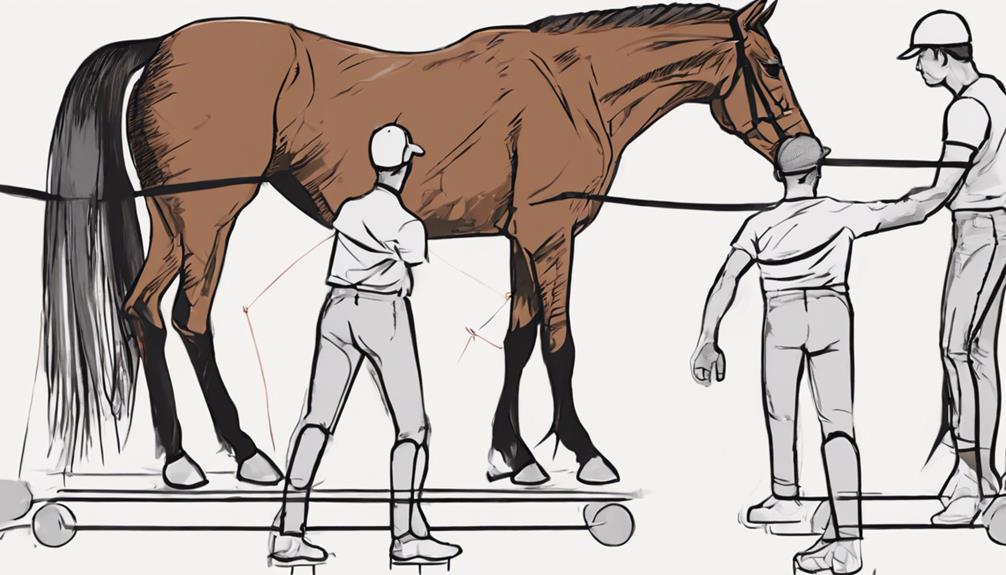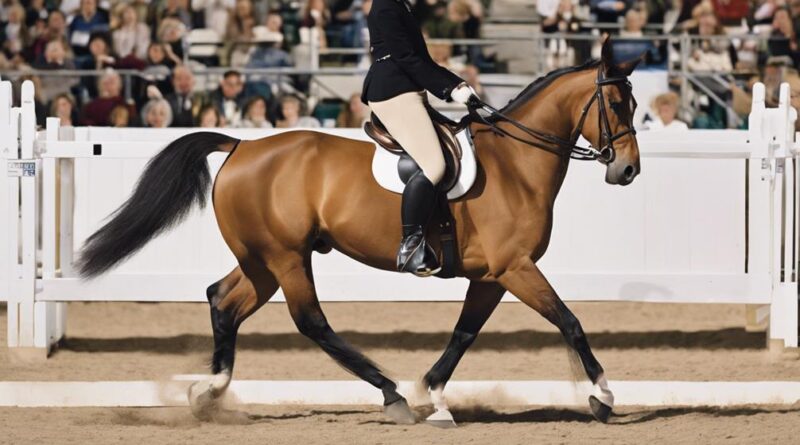Effective Training Techniques for Enhanced Equine Biomechanics
Boosting equine biomechanics begins with blending tried-and-true techniques with innovative approaches. From understanding the intricacies of horse anatomy to tailoring bespoke training programs, each step plays a pivotal role in enhancing your horse's performance.
But what happens when traditional methods fall short, and your equine partner hits a plateau? That's where the significance of incorporating cutting-edge training strategies comes into play, ensuring your horse reaches its full potential.
Importance of Equine Biomechanics
Why is understanding equine biomechanics crucial for training horses effectively? Equine biomechanics plays a vital role in both performance enhancement and injury prevention. By delving into biomechanics assessment and gait analysis, trainers can optimize training techniques to improve a horse's overall performance and well-being.
When you grasp equine biomechanics, you can fine-tune your training methods to enhance the horse's performance. Through biomechanics assessment, you can identify areas where the horse may be struggling or could improve. By understanding how a horse moves and the mechanics behind its movements, you can tailor exercises to target specific muscle groups, improve coordination, and ultimately boost performance levels.
Moreover, a deep understanding of equine biomechanics is essential for injury prevention. Gait analysis allows you to detect any irregularities or asymmetries in the horse's movement patterns that could potentially lead to injuries over time. By addressing these issues through proper training techniques, you can help minimize the risk of strains, sprains, and other common equine injuries.
Understanding Horse Anatomy
To effectively enhance your understanding of equine biomechanics for training purposes, it's essential to grasp the fundamental aspects of horse anatomy. Understanding muscle anatomy and joint movement in horses is crucial for developing effective training programs that promote optimal performance and reduce the risk of injuries.
Horse muscle anatomy plays a significant role in their ability to move efficiently. The muscles in a horse's body are responsible for generating the force needed for movement. Different muscle groups work together to allow the horse to perform various actions, such as trotting, cantering, or jumping. By understanding the location and function of these muscles, you can tailor your training techniques to strengthen specific areas and improve overall performance.
Joint movement is another critical aspect of horse anatomy to consider when training for enhanced biomechanics. Joints act as the connection points between bones, allowing for flexibility and movement. Proper joint function is essential for ensuring that the horse can perform tasks comfortably and efficiently. By understanding how different joints work and their range of motion, you can adjust your training programs to support healthy joint function and prevent injuries.
Tailoring Training Programs for Horses
When designing training programs for horses, consider their individual abilities and strengths to maximize performance gains and ensure their well-being. Taking an individualized approach to each horse's training is essential for their development. Just like humans, horses have unique characteristics that influence how they respond to different training methods. By tailoring the training program to suit the specific needs of each horse, you can optimize their progress and prevent overworking certain areas.
Specialized techniques play a crucial role in tailoring training programs for horses. These techniques involve customizing exercises and routines based on the horse's strengths, weaknesses, and goals. For example, if a horse struggles with flexibility, incorporating specific stretching exercises can help improve their range of motion and overall performance. Likewise, if a horse excels in certain areas, focusing on advanced training drills can further enhance their skills.
Observing your horse's reactions to different training stimuli is also key in designing an effective program. Pay attention to how they respond to various exercises, equipment, and environments. This feedback can guide you in adjusting the training regimen to suit their preferences and optimize their performance.
Incorporating Strength and Conditioning
Incorporating strength and conditioning into your horse's training regimen is essential for enhancing performance and overall fitness. Equine fitness relies heavily on the development of muscle strength and endurance. By incorporating specific strength and conditioning exercises tailored to your horse's needs, you can help improve their overall athletic ability and reduce the risk of injuries.
To enhance equine fitness, focus on exercises that target muscle development. Implement exercises such as hill work, pole work, and cavaletti exercises to build muscle strength and improve coordination. These exercises not only help in muscle development but also aid in enhancing your horse's balance and agility.
When incorporating strength and conditioning into your horse's routine, it's crucial to start gradually and increase the intensity over time. Monitor your horse's progress closely and adjust the training program as needed to prevent overexertion. Remember, consistency is key in developing equine fitness, so ensure that the training regimen is followed regularly.
Utilizing Groundwork Exercises
Groundwork exercises play a crucial role in enhancing your horse's overall physical and mental well-being. Engaging in these exercises not only benefits your horse physically but also aids in refining their techniques for better performance. Here are some key benefits and tips for utilizing groundwork exercises effectively:
- Improved Communication: Groundwork fosters a stronger bond between you and your horse, enhancing communication and mutual understanding.
- Enhanced Focus: By incorporating groundwork into your training routine, your horse learns to focus better on tasks, leading to improved performance in various disciplines.
- Physical Conditioning: These exercises help in building your horse's strength, flexibility, and coordination, which are essential for overall fitness and biomechanical efficiency.
- Behavioral Correction: Groundwork can assist in addressing behavioral issues by establishing boundaries and promoting respectful behavior.
To make the most of your groundwork sessions, focus on consistency and patience. Pay attention to your body language and cues, ensuring clarity in your instructions to the horse. Regularly assess your horse's progress and adjust the exercises accordingly to continue challenging them.
Implementing Corrective Exercises
To address specific biomechanical issues in your horse, consider implementing corrective exercises that target areas of weakness or imbalance. Corrective techniques play a crucial role in improving your horse's overall biomechanics and performance. By focusing on targeted exercises, you can effectively address any imbalances or weaknesses that may be hindering your horse's movement.
When implementing corrective exercises, it's essential to tailor them to your horse's specific needs. Biomechanics drills can help isolate and strengthen particular muscle groups, improve flexibility, and enhance overall coordination. For instance, if your horse tends to have difficulty engaging its hindquarters, exercises such as hill work or cavaletti poles can aid in developing strength and proper movement patterns.
Additionally, incorporating exercises that promote symmetry and balance can greatly benefit your horse's biomechanics. Groundwork exercises like shoulder-in or leg yielding can encourage your horse to engage its core muscles and improve its overall body alignment. These exercises not only target specific areas of weakness but also contribute to the development of a more balanced and coordinated equine athlete.
Monitoring Progress and Adjusting

To ensure optimal results, it's crucial to closely monitor your horse's progress and make necessary adjustments in their corrective exercises as needed. Progress tracking allows you to evaluate the effectiveness of the training program and identify areas that require improvement. By paying attention to your horse's performance and making timely adjustments, you can help them achieve their biomechanical goals efficiently.
Here are some key points to consider when monitoring progress and adjusting:
- Regular Evaluation: Consistently assess your horse's movement patterns and overall performance to track improvements or setbacks accurately.
- Feedback Mechanism: Use feedback from training sessions to identify areas where your horse may need additional support or modifications in their exercises.
- Flexibility in Training: Be adaptable in your approach and willing to modify exercises based on your horse's response and progress.
- Consultation with Experts: Seek guidance from experienced trainers or equine professionals to gain valuable insights and ensure that your adjustments align with best practices in equine biomechanics.
Seeking Professional Guidance
For optimal guidance in enhancing your horse's biomechanics, seeking input from professional trainers or equine specialists is highly recommended. These experts can provide valuable insights through biomechanics analysis and offer tailored improvement strategies to maximize your horse's performance. By consulting with professionals, you can gain access to specialized knowledge and experience that can significantly benefit your training programs.
Expert advice from professional trainers is crucial in understanding the complexities of equine biomechanics. They can assess your horse's movement patterns, muscle development, and overall performance to pinpoint areas for enhancement. Through biomechanics analysis, these professionals can identify any irregularities or inefficiencies in your horse's movement, allowing for targeted training interventions to address these issues effectively.
In addition to biomechanics analysis, professional equine specialists can design specific improvement strategies based on your horse's unique needs. Whether it involves adjusting training techniques, incorporating new exercises, or implementing corrective measures, these specialists can create a comprehensive plan to optimize your horse's biomechanical function.
Frequently Asked Questions
How Can Equine Biomechanics Impact a Horse's Performance in Specific Disciplines Such as Dressage or Show Jumping?
When it comes to dressage or show jumping, equine biomechanics can greatly impact your horse's performance. Analyzing biomechanics helps understand how your horse moves, aiding in training techniques tailored to improve muscle development for specific disciplines.
Are There Any Common Misconceptions About Equine Biomechanics That Horse Owners Should Be Aware Of?
When it comes to equine biomechanics, there are common myths that horse owners should be aware of. Understanding these misconceptions is crucial for equine welfare.
Biomechanics education plays a key role in dispelling these myths and promoting performance enhancement for your horse.
What Role Does Nutrition Play in Supporting Enhanced Equine Biomechanics?
Nutrition is key for enhanced equine biomechanics. A balanced diet tailored to your horse's nutritional requirements can optimize performance.
Providing the right nutrients supports muscle strength, joint health, and overall movement. By focusing on dietary balance, you can help your horse achieve its full biomechanical potential.
Can Certain Environmental Factors Affect a Horse's Biomechanics and Overall Performance?
Certain environmental factors can affect a horse's biomechanics and overall performance. Weather conditions like extreme heat or cold can impact a horse's muscles and joints. Arena design plays a role too, as uneven footing can strain a horse's body.
Additionally, rider weight and equipment fit are crucial. A heavy rider or ill-fitting equipment can hinder a horse's movement and biomechanics, affecting their performance. It's important to consider these factors for your horse's well-being and optimal performance.
How Do Different Types of Footing or Surfaces Impact a Horse's Biomechanics During Training or Competition?
When you train or compete on different surfaces, like sand, grass, or synthetic footing, it affects your horse's biomechanics and performance. Surface effects can influence how your horse moves, jumps, or turns.
The variability in footing impacts your training by challenging your horse's muscles and balance. Understanding how different surfaces affect equine performance is crucial for optimizing training sessions and competition outcomes.
Conclusion
In conclusion, by incorporating effective training techniques for enhanced equine biomechanics, you can help your horse move more efficiently, prevent injuries, and improve overall performance.
Understanding your horse's anatomy, tailoring training programs, incorporating strength and conditioning, utilizing groundwork exercises, implementing corrective exercises, monitoring progress, and seeking professional guidance are all key components to achieving success in this area.
Remember, consistency and dedication are key to seeing improvements in your horse's biomechanics.
